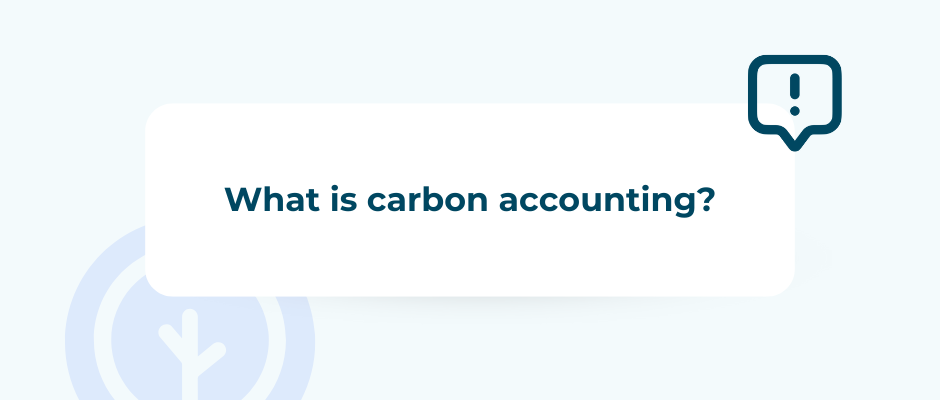What is carbon accounting? Definition
Reading time: 6 minutes
Reading time: 6 minutes

When your company prepares a climate strategy or carbon report, you need to understand carbon accounting’s definition—how to measure, track, and report greenhouse gas (GHG) emissions accurately and confidently. Think of carbon accounting as climate-watching with purpose: it helps you turn emissions data into informed decision-making.
In this guide, you’ll discover the nuts and bolts of carbon accounting, from Scopes 1, 2, and 3 to CO₂e, and how to choose the correct methodology—whether activity-based, spend-based, or a practical hybrid. You’ll learn why frameworks like the GHG Protocol matter and how EU rules like CSRD, EU ETS, and CBAM shape your reporting obligations.
We’ll also look at the business benefits, from operational savings to investor confidence, while giving you clear, practical steps to get started. You’ll see how tools like Tapio’s carbon accounting software can make the process easier, more collaborative, and compliant.
Let’s equip you to transform emissions data into strategy and measurable impact.
Carbon accounting—or greenhouse gas accounting—is the structured process of measuring an organisation’s total GHG emissions, expressed as CO₂ equivalent (CO₂e).
It provides a factual basis for setting reduction targets, complying with regulations, and reporting to stakeholders.
Where “carbon footprint” describes the result (total emissions), carbon accounting describes the process of gathering, calculating, and managing that data.
While the terms are often used interchangeably, “GHG accounting” technically covers all greenhouse gases, including methane (CH₄), nitrous oxide (N₂O), and fluorinated gases. “Carbon accounting” often focuses on CO₂, but in practice, it usually reports all gases converted into CO₂e for comparability.
CO₂e (carbon dioxide equivalent) is a standard unit that expresses the impact of all greenhouse gases in terms of the amount of CO₂ that would create the same global warming effect.
For example, methane (CH₄) and nitrous oxide (N₂O) have a more substantial warming potential than CO₂, so their emissions are multiplied by a specific factor (called the global warming potential) before being added into the total.
Using CO₂e ensures that emissions from different gases can be compared and summed in one consistent number—making reporting and target-setting clearer.
These are emissions from sources your company owns or directly controls.
Scope 2 – indirect energy emissions
It covers emissions from purchased energy—mainly electricity- and steam, heating, or cooling.
The most challenging category covers all other indirect emissions in your upstream and downstream value chain.
Examples include supplier manufacturing, transport, product use, waste disposal, and employee commuting. Scope 3 accounts for over 70% of total emissions for many EU companies.
Uses physical activity data (e.g. litres of fuel consumed × official emission factor).
This is the most accurate method when detailed operational data is available.
Uses financial expenditure data (e.g. € spent on goods × average emissions per € in that sector).
Useful when detailed activity data is missing, especially for Scope 3.
Many EU companies combine the two: use activity-based data where possible, fill gaps with spend-based.
Data quality is key regardless of method—emission factors should be up-to-date, region-specific, and transparent.
Tapio’s carbon accounting software can automate factor updates and ensure consistency across your reporting.
When done well—and ideally supported by a platform like Tapio’s carbon accounting software—carbon accounting delivers benefits far beyond compliance.
Getting started can feel complex, but breaking it into manageable steps—and using tools like Tapio’s carbon accounting software—makes it achievable.
Capturing the carbon accounting definition isn’t just about ticking a compliance box—it’s about building a strategic advantage in a low-carbon economy.
By systematically measuring your Scopes 1, 2, and 3 emissions, converting them into CO₂e, and following recognised standards, you’re creating a solid foundation for an effective carbon strategy.
EU regulations like CSRD, ETS, and CBAM mean the time to start is now. Beyond compliance, carbon accounting opens doors to operational efficiency, risk reduction, and market leadership.
The challenges—data gaps, complexity—are manageable with the right approach.Next step: map your primary emission sources, set a baseline, and choose a methodology aligned with the GHG Protocol. Tapio’s carbon accounting software can help you centralise your data, engage your team, and deliver transparent, exportable reports for regulators and stakeholders.

Tapio is a carbon management software that allows companies and consultants to calculate and reduce carbon emissions.